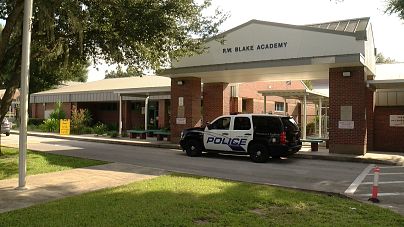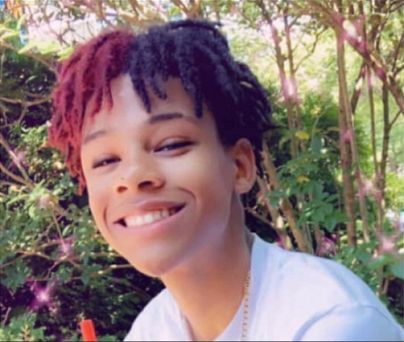"We see these terrible stories, and they are terrible, and we all immediately wonder, if this were happening to me, would people come to my aid?" one media expert said.
A boy was beaten by another student in a middle-school locker room as classmates filmed the attack.
A teen was fatally stabbed in an after-school brawl while a crowd of young people watched or videotaped the assault.
A man died by suicide after jumping in front of a subway train while holding his 5-year-old daughter, prompting two men to jump onto the tracks to save the girl while others recorded the event on their phones.
All three incidents occurred in the past three weeks, and some experts say they highlight how smartphones and social media may be shaping — and slowing — the human response to emergencies and tragic events.
After the stabbing death last week of 16-year-old Khaseen Morris on Long Island, New York, which other teens watched and filmed, a top elected official in the area appealed to the public for greater compassion.
"I want to plead with all our residents — not just our young people: If you see someone in serious danger, please use your phone to get help — not likes and shares," Nassau County Executive Laura Curran said last week.
But some sociologists and psychologists cautioned against an urge to cast social media users as narcissistic, callous attention seekers after such unsettling events.
***
"We see these terrible stories, and they are terrible, and we all immediately wonder, if this were happening to me, would people come to my aid?" said Keith Hampton, a professor in the department of media and information at Michigan State University.
"The truth is, there have always been that group of people who, when horrible things are happening, they might clench or read their newspaper or keep their hands in their pockets," he said. "Those same people exist today. They just have smartphones."
Other experts say social media and technology can shape behavior in good and bad ways.
Some people who record a horror in real time may be seeking likes and shares.
Others may plan to share the footage with law enforcement in hopes of helping to identify a suspect, for example. Still others may see videotaping as a way to ensure accountability, such as by filming potential police misconduct.
"Technology is like fire," said Jeff Hancock, a professor in Stanford University's department of communication. "It's deeply involved in our lives now. It warms our home or it can burn it down. Both are true."
A viral video of a boy's beating at a Florida middle schoolmay illustrate such a possible variety of intentions. Some classmates who videotaped the Sept. 10 incident at Blake Academy, a public school in Lakeland, might have been interested in collecting likes, shares and retweets on social media. But others might have been gathering evidence.
The boy's mother, Lauren Springfield, posted a video of the incident on Facebook that drew more than 6,000 views. It was later removed. In her post, Springfield said she received the video from a parent of a high school student and she expressed anger that other students didn't step in to help her son.
"This could have ended much differently, our child has one kidney and after getting kneed several times this could have resulted in permanent damage," Springfield said in the Facebook post that featured two images of her son being assaulted.
The boy's injuries included cuts above his eyebrow, bruising on his eye and welts on his head, she said.
The school suspended an unspecified number of boys who recorded the attack along with the boy who beat Springfield's son, school officials later said.
***
In the case of the fatal stabbing on Long Island, some witnesses may have taken action.
Nassau County police told NBC News that 14 calls were made to 911 during or after the attack.
Police have obtained two videos taken of the fight, the Nassau County police commissioner said at a community meeting Tuesday that was sponsored by police and billed as the "Dangers of Social Media," according to Newsday.
But, Commissioner Patrick Ryder added, "Nobody volunteered those videos for us. We had to find them and get them."
Authorities initially told NBC News at least 60 teens gathered around a parking lot to watch the confrontation, and some took video that was posted on social media. But the county police commissioner said at the meeting for area parents that about 20 people had been in the crowd. When NBC News attempted Thursday to clarify the number, Nassau police again said it was upward of 50 individuals.
Police arrested Tyler Flach, 18, who is accused of stabbing the other teen in what authorities said was a dispute over a girl. On Friday, authorities announced the arrest of another seven teens who face charges of second-degree gang assault.
***
Experts caution against concluding that people's behavior has worsened because of social media.
"We can't accurately say that people are worse or the bystander effect is worse today because of social media," said Pamela Rutledge, director of the Media Psychology Research Center at Fielding Graduate University in Santa Barbara, California.
Rutledge referred to hundreds of years of social and legal oppression in the U.S. that most people did nothing to stop.
According to the Equal Justice Initiative, between 1882 and 1968, more than 4,500 black people were lynched in the United States, often in front of cheering white crowds who bought postcards capturing scenes of torture and murder they witnessed.
In this era, what social media may be doing is giving bystanders a new place to focus their attention, a way to create distance between themselves and the terrible event, Rutledge said. Some people are opting to literally view events through their cellphone camera.
Filming may reorient the bystander's concerns from the event happening in front of them to the potential audience for their recording and what those viewers may think.
"All of that could decrease empathy for victims, a sense of any involvement, connection or obligation," Rutledge said. "But social media doesn't create that. It didn't spawn those tendencies in people. They existed. Now, they are expressing themselves in new forms."
Hancock echoed this view.
"Social media can intensify things we have already observed in human life and human social behavior, there's no question about that. But the saying is 'psychology beats technology every time' for a reason," he said.
Social scientists have long pointed to the "bystander effect" to explain why when, large groups of people witness emergencies or crimes, individuals are less likely to intervene.
But the case that pushed the concept into public consciousness turned out to have been misunderstood. Early reporting on the 1964 murder of Kitty Genovese relayedan ugly but compelling set of events: A young woman was attacked in her Queens neighborhood as neighbors looked out their windows and watched but never intervened or called police. Subsequent reporting found that police were summoned and some of the crime happened out of clear view.
***
This week, when a manjumped in front of an oncoming subway train in the Bronx while holding his 5-year-old daughter, one of the two men who climbed onto the tracks to rescue the child later told The New York Times that he was shocked by how many people took out their phones but did nothing to help.
"It was just panicking," Antonio Love said of the incident Monday, in which the father died but the girl survived. "Like, regular New Yorkers, pulling out their phones. Really? Let's get down there and help."
But in such a chaotic situation, it might be unfair to assume the intent of those who recorded now-viral videos of the dramatic rescue, said psychologist Sara Konrath, a social psychologist and associate professor at the Lilly Family School of Philanthropy in Indianapolis.
Many onlookers may have seen recording the rescue as a way of being engaged because they could later share that footage with news reporters or police.
"It's hard to interpret why people were videotaping," Konrath said.
The three recent incidents may highlight the need for a public discussion of how best to respond to dramatic, urgent events, experts said.
"I do think that we need to start teaching people that there are a set of behaviors that we worry about offline that we must also worry about online," said Rutledge, "like what it means to be a good citizen."













